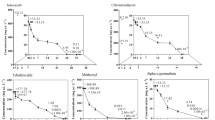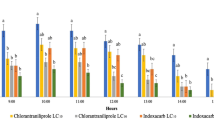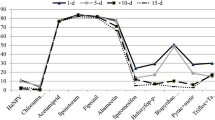Abstract
The lethal and sublethal effects of chlorantraniliprole against Spodoptera exigua (Hübner) were evaluated under laboratory conditions by oral exposure of neonate larvae to the compound. The 72 h LC50 value of this insecticide to S. exigua was found to be 12.747 µg l−1. A progressive larval mortality of 24.32% for LC30 treatment and 42.61% for LC50 treatment was observed from 4th to 6th day after exposure, which resulted in the reduced pupation rates in exposure groups. The sublethal effects of this chemical were indicated by prolongation of larval period, the increase of pupal weight and decrease in hatch rate of egg. Chlorantraniliprole at LC30 and LC50 rate significantly delayed larval development; the developmental duration of surviving larvae was extended for 22.5 and 28.6%, respectively, compared with that of control group. LC30 treatment increased the mean weight of pupa and induced to the production of heavier pupa (>150 mg). In LC50 treatment, heavier pupa also showed up but the mean weight of pupa was not influenced. The egg hatch rate in LC50 group was significant lower than that in control and LC30 groups. No significant differences in pupal duration, emergence rate, sex ratio, egg number per female, and longevity of adults were observed among treatments. Chlorantraniliprole had exceptional activity against S. exigua according to concentration–response bioassay in laboratory, and the toxicities were primarily resulted from immediate lethality.



Similar content being viewed by others
References
Abbott VA, Nadeau JL, Higo AH, Winston ML (2008) Lethal and sublethal effects of imidacloprid on Osmia lignaria and clothianidin on Megachile rotundata (Hymenoptera: Megachilidae). J Econ Entomol 101:784–796
Aldosari SA, Watson TF, Sivasupramaniam S, Osman AA (1996) Susceptibility of field populations of beet armyworm (Lepidoptera: Noctuidae) to cyfluthrin, methomyl, and profenofos, and selection for resistance to cyfluthrin. J Econ Entomol 89:1359–1363
Borchert DM, Walgenbach JF, Kennedy GG (2005) Assessment of sublethal effects of methoxyfenozide on oriental fruit moth (Lepidoptera: Tortricidae). J Econ Entomol 98:765–771
Chen Y, Ruberson JR, Olson DM (2008) Nitrogen fertilization rate affects feeding, larval performance, and oviposition preference of the beet armyworm, Spodoptera exigua, on cotton. Entomol Exp Appl 126:244–255
Cordova D, Benner EA, Sacher MD, Rauh JJ, Sopa JS, Lahm GP, Selby TP, Stevenson TM, Flexner L, Gutteridge S, Rhoades DF, Wu L, Smith RM, Tao Y (2006) Anthranilic diamides: a new class of insecticides with a novel mode of action, ryanodine receptor activation. Pestic Biochem Physiol 84:196–214
Eizaguirre M, Tort S, López C, Albajes R (2005) Effects of sublethal concentrations of Bacillus thuringiensis on larval development of Sesamia nonagrioides. J Econ Entomol 98:464–470
Galvan TL, Koch RL, Hutchison WD (2005) Effects of spidosad and indoxacarb on survival, development, and reproduction of the multicolored Asian lady beetle (Coleoptera: Coccinellidae). Biol Control 34:108–114
Hannig GT, Ziegler M, Marcon PG (2009) Feeding cessation effects of chlorantraniliprole, a new anthranilic diamide insecticide, in comparison with several insecticides in distinct chemical classes and mode-of-action groups. Pest Manag Sci 65:969–974
Insecticide Resistance Action Committee (IRAC) (2010) IRAC mode of action classification. v 7.0. IRAC Mode Action Working Group. http://www.irac-online.org/wp-content/uploads/2009/09/MoA-classification_v7.0.4-5Oct10.pdf
Ioriatti C, Anfora G, Angeli G, Mazzoni V, Trona F (2009) Effects of chlorantraniliprole on eggs and larvae of Lobesia botrana (Denis & Schiffermüller) (Lepidoptera: Tortricidae). Pest Manag Sci 65:717–722
Jia B, Liu Y, Zhu YC, Liu X, Gao C, Shen J (2009) Inheritance, fitness cost and mechanism of resistance to tebufenozide in Spodoptera exigua (Hübner) (Lepidoptera: Noctuidae). Pest Manag Sci 65:996–1002
Knight AL, Flexner L (2007) Disruption of mating in codling moth (Lepidoptera: Tortricidae) by chlorantranilipole, an anthranilic diamide insecticide. Pest Manag Sci 63:180–189
Lahm GP, Selby TP, Freudenberger JH, Stevenson TM, Myers BJ, Seburyamo G, Smith BK, Flexner L, Clark CE, Cordova D (2005) Insecticidal anthranilic diamides: a new class of potent ryanodine receptor activators. Bioorg Med Chem Lett 15:4898–4906
Lahm GP, Stevenson TM, Selby TP, Freudenberger JH, Cordova D, Flexner L, Bellin CA, Dubas CM, Smith BK, Hughes KA, Hollingshaus JG, Clark CE, Benner EA (2007) Rynaxypyr™: a new insecticidal anthranilic diamide that acts as a potent and selective ryanodine receptor activator. Bioorg Med Chem Lett 17:6274–6279
Lahm GP, Cordova D, Barry JD (2009) New and selective ryanodine receptor activators for insect control. Bioorg Med Chem Lett 17:4127–4133
LeOra Software (2002) Polo plus. A use’s guide to probit or logit analysis. LeOra Software, Berkeley, CA
Liu YJ, Shen JL (2002) Monitoring for four groups of insecticide resistance in Spodoptera exigua (Lepidoptera: Noctuidae). Cotton Sci 14:356–360
Liu YJ, Shen JL, Jia B (2002) Occurrence and resistance status of the beet armyworm, Spodoptera exogua (Hübner). Cotton Sci 14:305–309
Liu W, Mu W, Zhu B, Liu F (2008) Effects of tebufenozide on the biological characteristics of beet armyworm (Spodoptera exigua Hübner) and its resistance selection. Sci Agric Sin 41(5):1366–1372
Moreau C, Bauce É (2003) Lethal and sublethal effects of single and double applications of Bacillus thuringiensis variety kurstaki on spruce budworm (Lepidotpera: Tortricidae) larvae. J Econ Entomol 96:280–286
Moulton JK, Pepper DA, Dennehy TJ (2000) Beet armyworm (Spodoptera exigua) resistance to spinosad. Pest Manag Sci 56:842–848
Moulton JK, Pepper DA, Jansson RK, Dennehy TJ (2002) Pro-active management of beet armyworm (Lepidoptera: Noctuidae) resistance to tebufenozide and methoxyfenozide: baseline monitoring, risk assessment, and isolation of resistance. J Econ Entomol 95:414–424
Nauen R (2006) Insecticide mode of action: return of the ryanodine receptor. Pest Manag Sci 62:690–692
Osoria A, Martinez AM, Schneider MI, Diaz O, Corrales JL, Aviles MC, Smagghe G, Pineda S (2008) Monitoring of beet armyworm resistance to spinosad and methoxyfenozide in Mexico. Pest Manag Sci 64:1001–1007
Pineda S, Schneider MA, Smagghe G, Martinez AM, Estal PD, Vinuela E, Valle J, Budia F (2007) Lethal and sublethal effects of methoxyfenozide and spinosad on Spodopera littoralis (Lepidoptera: Noctuidae). J Econ Entomol 103(3):662–667
Rodríguez Enríquez CJ, Pineda S, Figueroa JI, Schneider MJ, Martínez AM (2010) Toxicity and sublethal effects of methoxyfenozide on Spodoptera littoralis (Lepidoptera: Noctuidae). J Econ Entomol 100(3):773–780
SAS Institute (1999) SAS/STAT user’s guide, 8th edn. SAS Institute, Cary
Sattelle DB, Cordova D, Cheek TR (2008) Insect ryanodine receptors: molecular targets for novel pest control chemicals. Invert Neurosci 8:107–119
Seth RK, Kaur JJ, Rao DK, Reynoldse SE (2004) Effects of larval exposure to sublethal concentrations of the ecdysteroid agonists RH-5849 and tebufenozide (RH-5992) on male reproductive physiology in Spodoptera litura. J Insect Physiol 50:505–517
Stapel JO, Waters DJ, Ruberson JR, Lewis WJ (1998) Development and behavior of Spodoptera exigua (Lepidoptera: Noctuidae) larvae in choice tests with food substrates containing toxins of Bacillus thuringiensis. Bio Control 11:29–37
Teixeira LA, Gut LJ, Wise JC, Isaacs R (2009) Lethal and sublethal effects of chlorantraniliprole on three species of Rhagoletis fruit flies (Diptera: Tephritidae). Pest Manag Sci 65:137–143
Acknowledgments
This research was funded by grants from China Natural Science Foundation (No. 30671369 and 30971946).
Author information
Authors and Affiliations
Corresponding author
Additional information
Communicated by K. J. Gorman.
Rights and permissions
About this article
Cite this article
Lai, T., Su, J. Effects of chlorantraniliprole on development and reproduction of beet armyworm, Spodoptera exigua (Hübner). J Pest Sci 84, 381–386 (2011). https://doi.org/10.1007/s10340-011-0366-1
Received:
Accepted:
Published:
Issue Date:
DOI: https://doi.org/10.1007/s10340-011-0366-1




